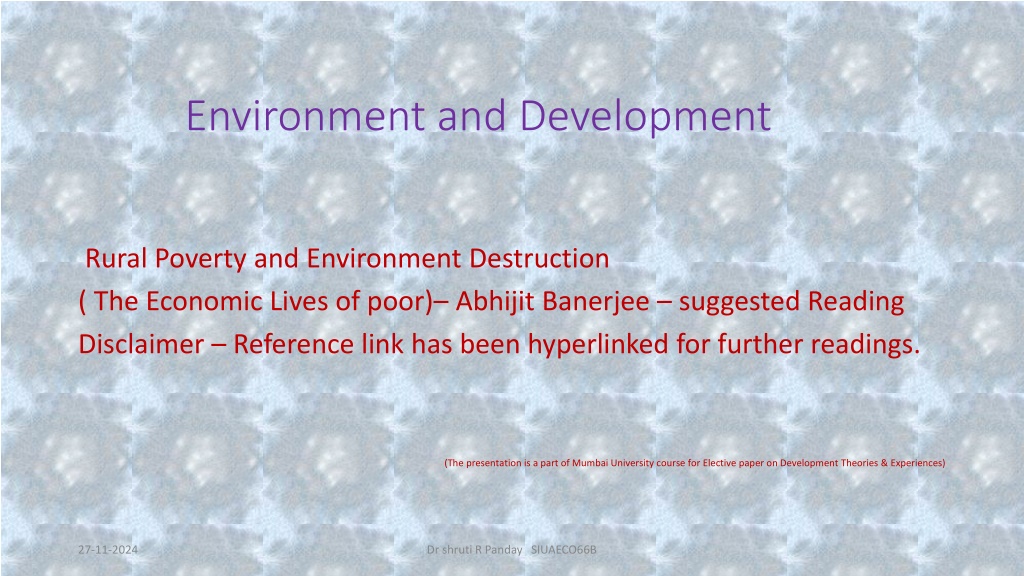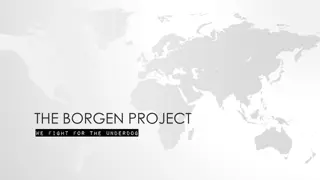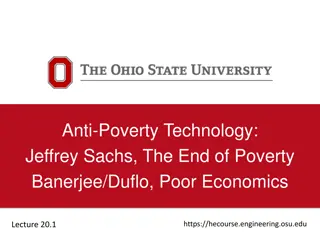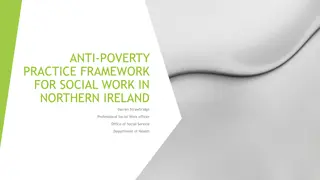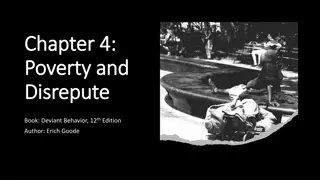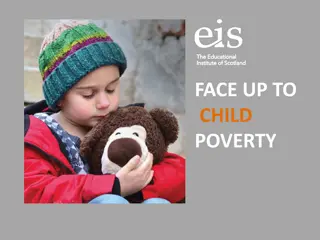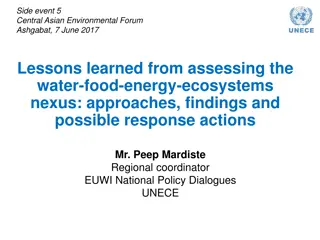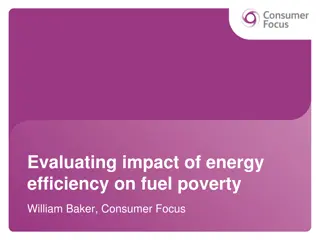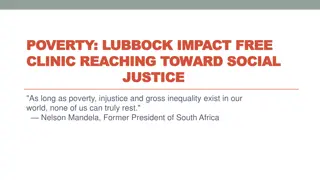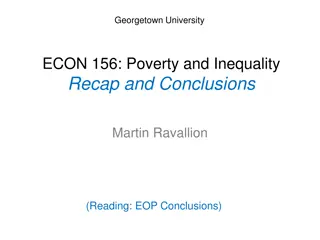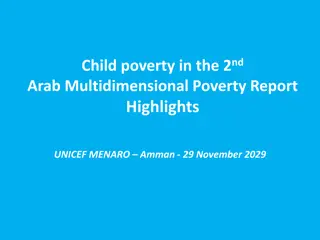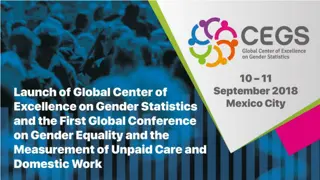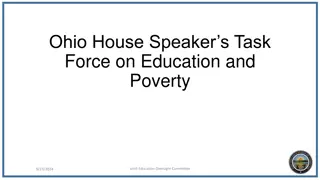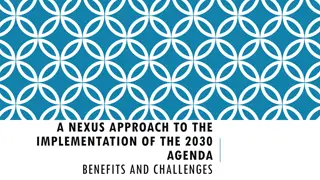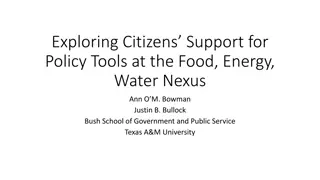Understanding the Poverty-Environment Nexus
Environmental degradation is intricately linked to poverty, where the poor often bear the brunt of resource depletion and damage. The cyclical relationship between poverty and the environment, known as the poverty-environment nexus, highlights how environmental issues can exacerbate poverty and vice versa.
Download Presentation

Please find below an Image/Link to download the presentation.
The content on the website is provided AS IS for your information and personal use only. It may not be sold, licensed, or shared on other websites without obtaining consent from the author. Download presentation by click this link. If you encounter any issues during the download, it is possible that the publisher has removed the file from their server.
E N D
Presentation Transcript
Environment and Development Rural Poverty and Environment Destruction ( The Economic Lives of poor) Abhijit Banerjee suggested Reading Disclaimer Reference link has been hyperlinked for further readings. (The presentation is a part of Mumbai University course for Elective paper on Development Theories & Experiences) 27-11-2024 Dr shruti R Panday SIUAECO66B
Poverty and Environment Degradation Environmental degradation is usually understood in terms of high use of scarce nonrenewable resources, damage or destruction of key renewable resources (such as soils and forests) and the generation of wastes that are not easily assimilated or broken down by natural processes. According to the Brundtland Report, poverty is a major cause and effect of global environmental problems (World Commission on Environment and Development 1987). First report on Human Development mentions, Poverty is one of the greatest threats to the environment (UNDP 1990). 27-11-2024 Dr shruti R Panday SIUAECO66B
Poverty and environment-- Close Link People living in poverty may not be the principal cause of environmental damage, but they often bear the brunt of environmental damage . They are often caught in a downward spiral. whereby the poor are forced to deplete resources to survive, and this degradation of the environment further impoverishes people. When this self reinforcing downward spiral becomes extreme, people are forced to move in increasing numbers to marginal and ecologically fragile lands or to cities. https://www.unescap.org/sites/default/files/CH09.PDF 27-11-2024 Dr shruti R Panday SIUAECO66B
27-11-2024 Dr shruti R Panday SIUAECO66B
Poverty-Environment nexus. The poor depend heavily on the open access resources like the forests, pastures, water resources that leads to their over exploitation Animals like sheep or goats that act as capital resource for the rural poor degrade the vegetation and soil faster than the livestock of the richer rural population like buffaloes. Cultivable land degrades quickly due to lack of investment for maintaining the soil quality that erodes the soil fertility. Land tenure system can also play a crucial role in the investment for maintaining soil quality. Since the environment as in the most developed countries is not an amenity but a necessary input for the rural households. environmental degradation in turn implies a shrinking input base for the poor households that increase the severity of poverty. This cyclical relationship is commonly referred to as the poverty-environment nexus. https://ageconsearch.umn.edu/record/21201/files/sp06bh01.pdf 27-11-2024 Dr shruti R Panday SIUAECO66B
27-11-2024 Dr shruti R Panday SIUAECO66B
The environment-poverty nexus is a two-way relationship. Environment affects poverty situations in three distinct dimensions : by providing sources of livelihoods to poor people, by affecting their health by influencing their vulnerability. On the other hand, poverty also affects environment in various ways: by forcing poor people to degrade environment, by encouraging countries to promote economic growth at the expense of environment, by inducing societies to downgrade environmental concerns 27-11-2024 Dr shruti R Panday SIUAECO66B
27-11-2024 Dr shruti R Panday SIUAECO66B
Four forms of poverty based on land use and environment are evident in the region-- The first form of poverty occurs in areas characterized by active and productive agricultural land . Though it has the potential of income generation, yet the efficient and equitable utilization of resources get hampered by social cultural and economic factors such as low levels of access to land, resources or jobs. In the poorest areas, a large unemployed are concentrated in mainly two classes: landless workers and small farmer. The second form of poverty occurs in areas of marginal lands (deserts, uplands, and already degraded lowlands) with few opportunities for increasing agricultural productivity or for economic diversification. Such areas are generally very low in productivity, and problems are compounded by unsustainable agricultural practices. Approximately 60 per cent of the poor in the region are estimated to be living on these marginal lands. 27-11-2024 Dr shruti R Panday SIUAECO66B
The third group of poor and vulnerable people inhabits coastal areas with inadequate or vast depleting marine resources. Historically ,people are attracted to such areas due to economic development, ports and trade but subsequently the pace of development destroys or depletes the very resources that are fueling its growth and survival of fisher community like Kolis of Mumbai . The fourth form of poverty is experienced by the poor inhabitants of urban slums and squatter settlements, where there is a constant exposure to poor sanitary and environmental conditions. poverty has its facet of geographical concentration with serious localized degradation. High population density and economic growth along with an inequitable distribution of productive assets leads to neglect of adoption of sustainable development practices. Impoverished communities also tend to rely disproportionately on common property resources such as forest and pasture, which are vulnerable to degradation when exploited by growing numbers of people. https://www.unescap.org/sites/default/files/CH09.PDF 27-11-2024 Dr shruti R Panday SIUAECO66B
Delinking poverty with environmental Degradation-- 1. The poverty-environment nexus basically stems from low incomes. The advocates of above statement argues that poor people degrade the environment due their overdependence on natural resources. It basically explain the poverty-environment nexus in terms of income levels negating the complexity in poverty-environment nexus discourse. Questions of ownership of natural resources, access to common resources, the strength or weakness of communities and local institutions, the way people cope with risk and uncertainty, the way people use scarce time all these are important in explaining the environmental behavior of poor people. Many of the natural resources that are degraded are communal property. 227-11-2024 Dr shruti R Panday SIUAECO66B
2. Downward spiral hypothesis: - The hypothesis maintains that poor people and environmental damage are often caught in a downward spiral. People in poverty are forced to deplete resources to survive and this degradation of environment further impoverishes people. It is a rather simplistic view of a much more complex reality. Environmental degradation can sometimes be associated with poverty but there is not necessarily a direct causal relationship. Other factors also shape human behavior to the environment. The danger of the Downward Spiral Hypothesis is that it may often lead to policies that either reduce poverty (often in the short run) at the expense of the environment or protect the environment at the expense of poor people. 27-11-2024 Dr shruti R Panday SIUAECO66B
3. Environmental Kuznets Curve: The Environmental Kuznets Curve shows a relationship between air pollution and economic growth. It maintains that pollution will increase initially with economic growth, but if growth continues and as society becomes more affluent, pollution will be reduced. Thus, by measuring economic growth in terms of per capita income in an economy, it establishes an inverted U-shaped curve . It was criticized on conceptual, statistical as well as policy grounds. The removal of subsidies, the internalisation of externalities and the identification of property rights can change the relationship between income levels and levels of environmental degradation. 4. Beckerman Hypothesis: The hypothesis maintains that as growth provides accumulated assets that can be used to ameliorate environmental degradation, it makes sense to degrade now and pay later to put things right. It ignores intergenerational equity issue. It basically says that there will be physical degradation at present, but that monetary compensation will be made in future, without answering how this would provide the same sort of opportunities as those enjoyed by the present generation or how compensation would be translated into physical natural resources or how the amount and the nature of future compensation are agreed upon. 27-11-2024 Dr shruti R Panday SIUAECO66B
5. Porter Hypothesis: Porter argues that high levels of environmental protection are compatible with high levels of economic growth and may encourage innovation that supports growth. But the hypothesis can lead to an extreme situation whereby environmental standards are imposed on trade. Using trade restrictions in the name of environmental standards is protectionism. For domestic environmental problems, such restrictions are inefficient for transboundary problems, they are both inefficient and inequitable. 6. Affluent vs Environment degradation Since per capita resource use is five times greater in industrial countries than in developing countries, it has been asserted that sustainable levels of material flows will not be reached unless the material intensity in industrial countries is reduced . 27-11-2024 Dr shruti R Panday SIUAECO66B
The deconstruction of the myth that poor people are the principal creators of environmental damage calls for revisiting some of the policy issues like the ownership of common resources, the legal framework, local management of common properties and the issue of time use by women. It also suggests that the issue of environmental degradation cannot be left to growth alone and justifying a passive attitude to policy needs. https://www.sarpn.org/documents/d0000349/UNDP_Report_5.pdf 27-11-2024 Dr shruti R Panday SIUAECO66B
